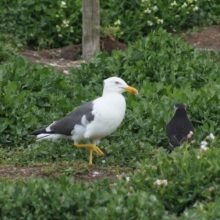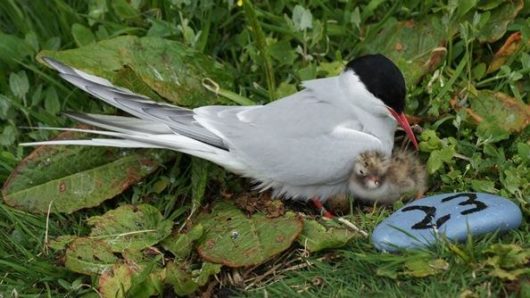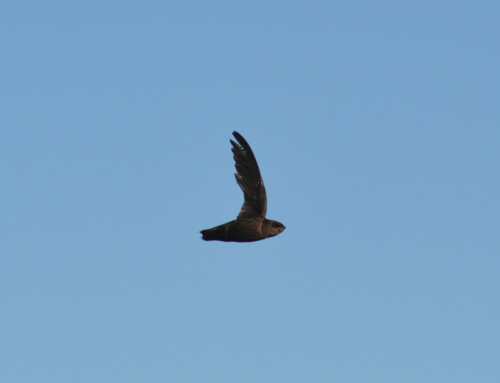LINKED PAPER
An evaluation of canes as management technique to reduce predation by gulls on ground nesting seabirds. Boothby,C., Redfern, C. & Schroeder, J. 2019. IBIS. DOI: 10.1111/ibi.12702. VIEW
Predation from large gulls has been found to limit the nesting success of a number of seabird species, from terns (Hernández-Matías et al. 2003) to Guillemots Uria aalge (Birkhead 1977), and this predation pressure has also led to the abandonment of breeding grounds (Whittam & Leonard 1999). As a result, many habitat managers of seabird colonies are keen to limit the impact of large gulls. Despite this, the protection of gulls is also of conservation importance. While there has been some research into using monofilament lines (Morris et al.1992, Scopel & Diamond 2017) and relocation of gull colonies (Ackerman et al. 2014), most of the research on limiting gull predation centres on culling gulls.
In some areas, including the Farne Islands, located off of the east coast of the United Kingdom, canes are used to deter large gulls. This method of protection is inexpensive and easy to set up, but despite this, the effectiveness of this method has not previously been tested.
A pilot experiment was conducted over a breeding season in 2016 at the National Trust’s Farne Islands, to look at the effectiveness of canes to deter gulls. The site only has avian predators and is therefore an ideal site for such an experiment. The archipelago of islands are home to approximately 2000 Arctic Tern Sterna paradisaea pairs during the breeding season, in addition to 1,600 pairs of European Herring gulls Larus argentatus and Lesser Black-backed gulls Larus fuscus, as well as a few pairs of Great Black-backed gulls Larus marinus (Steele 2013, Steele 2015).
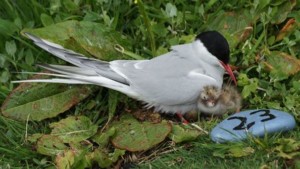
Figure 1 Arctic Tern Sterna paradisaea, with chick, on the Farne Islands. The numbered stones allow the nests to be easily monitored and the nesting success recorded © Michael Pentleton
We looked at four sites of Arctic Terns across two islands (Inner Farne and Brownsman). The terns started laying from the 14th May, and at this point each area was divided into three treatments: no canes, low-density canes (2 m apart) and high density canes (1 m apart).

Figure 2 The high density canes on site B on Inner Farne. All canes were placed in at an angle for ease, given a shallow soil cap © Claire Boothby
The sites were monitored for two hours from sunrise and for another hour in the early evening, after visitors had left the islands. The sites were monitored at the same time using trail cameras and direct observation. We recorded whether or not gulls were seen swooping in, making a predation attempt, and whether they managed to take an egg or chick.
Over the course of the breeding period the colonies were monitored for over 300 hours, and over that time, across the four experimental sites, 116 predation attempts from gulls were recorded. Only 41 of the predation attempts resulted in an Arctic Tern egg or chick being taken (Figure 3). The caned areas received less than half of the number of predation attempts, with a 52% and 43% reduction in predation attempts in the high and low density caned areas, respectively, compared to the control areas with no canes. Therefore, the canes did seem to act as a deterrent, to limit predatory activity by gulls in these areas. Interestingly though, there was not a significant difference between the two cane densities
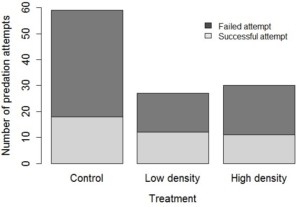
Figure 3 Total number of predation attempts made by Larus spp. from four experimental sites of breeding Sterna paradisaea, showing both failed and successful attempts, across three treatments of cane density
At the beginning of the study, we expected that canes may impede the ability of large gulls to successfully take Arctic Tern Sterna paradisaea eggs or chicks. However, although the canes seemed to act as a deterrent to predation attempts, when birds ignored the canes and tried anyway they were just as successful as in the areas without canes. In short, canes seem to deter the gulls from trying, but those that did try were just as likely to be successful as in the control areas.
These initial results are positive and it would be good to look at this method over multiple breeding seasons and link it to the overall productivity of the nesting seabirds. It would also be worth monitoring whether the deterrent pushes predation elsewhere and the subsequent impact of this. While only anecdotal, the rangers witnessed higher levels of predation on the adjacent Sandwich Tern Sterna sandvicensis colony, and on the Guillemots Uria aalge on the cliffs. We also know that from other deterrents that their effectiveness could be reduced over time (Stickley et al. 1995).
Further research is needed to support these findings but as the canes are of minimal cost and easy to set-up, this pilot study indicates that they could provide a useful and versatile tool for conservation managers.
Nominate this article for a BOU Science Communication Award.
References
Ackerman, J.T., Herzog, M.P, Hartman, C.A. & Herring, G. 2014. Forster’s Tern chick survival in response to a managed relocation of predatory California Gulls. The Journal of Wildlife Management 78: 818–829. VIEW
Birkhead, T.R. 1977. The effect of habitat and density on breeding success in the Common Guillemot (Uria aalge). Journal of Animal Ecology 46: 751-764. VIEW
Henández-Matías, A., Jover, L. & Ruiz, X. 2003. Predation on Common Tern eggs in relation to sub-colony size, nest aggregation and breeding synchrony. Waterbirds 26: 280-289. VIEW
Morris, R. D., Blokpoel, H., & Tessier, G. D. 1992. Management efforts for the conservation of Common Tern Sterna hirundo colonies in the Great Lakes: two case histories. Biological Conservation 60: 7-14. VIEW
Scopel, L. C., & Diamond, A. W. 2017. The case for lethal control of gulls on seabird colonies. The Journal of Wildlife Management 84: 572-580. VIEW
Steel, D. 2013. Birds on the Farne Islands 2012. In: Redfern, C. (ed.) Northumbrian Naturalist, Farne Islands Wildife 2012. Newcastle upon Tyne, The Natural History Society of Northumbria, pp. 10-69. VIEW
Steel, D. 2015. Birds on the Farne Islands 2014. In: Redfern, C. (ed.) Northumbrian Naturalist, Farne Islands Wildife 2014. Newcastle upon Tyne, The Natural History Society of Northumbria, pp. 10-47. VIEW
Stickley, A.R., Mott, D.F. & King, J.O. 1995. Short-term effects of an inflatable effigy on cormorants at catfish farms. Wildlife Society Bulletin 23: 73-77. VIEW
Image credits
Featured image: Lesser Black-backed Gull Larus fuscus © Claire Boothby




